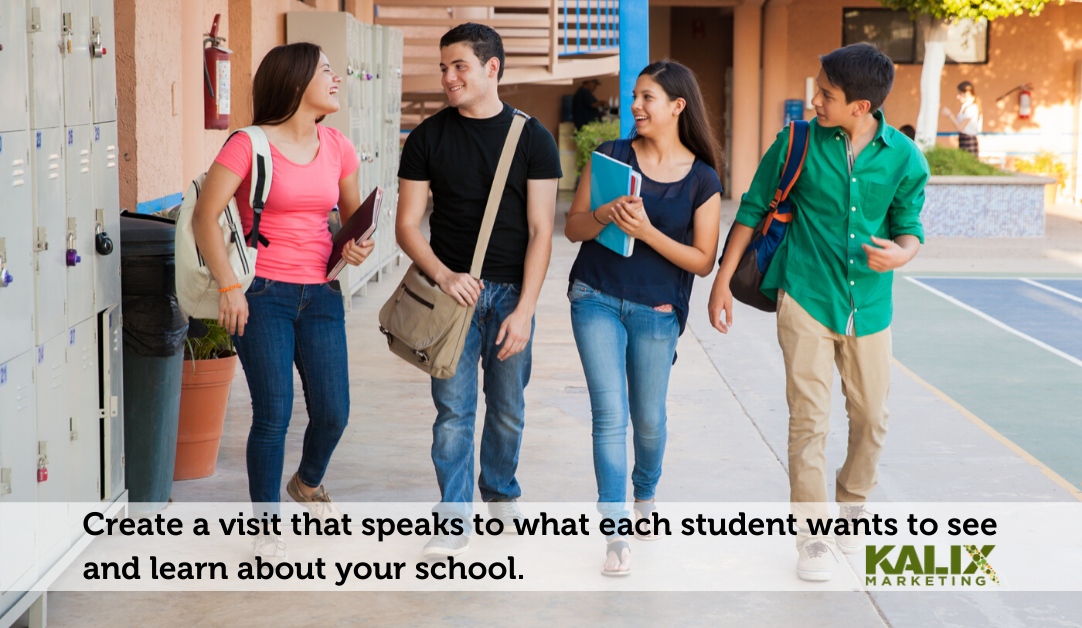It’s fall visiting time during admissions season for independent schools. The goal of hosting families is to show your school in the best possible light. Create a visit that speaks to what each student wants to see and learn about your school, and how they can do what they love in your program.
First, manage your expectations.
In today’s admissions process, a prospective family can start at any point. They might apply before they visit or vice versa. Most schools are less strict about the way families enter the process as they were in the past.
Every successful visit, no matter where the family is in the admissions process, begins with understanding and managing their expectations. It’s all about tailoring the experience and making people feel special. Make sure your staff knows what the rules of engagement are for all families including alumni and current parents.
Determine beforehand who sees visitors at your school. Does everyone see the Head of School? The division head?
What is the plan when alumni and current parents visit? Are they greeted by someone different? Do you give them a special gift?
Visiting day is NOT Training day.
Train every staff member and admissions volunteer (student, parent and alumni) well before visitors set foot on your campus. Provide everyone with your elevator speech, FAQs they may be asked and current statistics (enrollment, etc.) and make sure they have a copy of the FAQs and stats on the day of the visit. Better to check a list for the right answer than to make something up or say “I don’t know.”
Be clear on how you want visitors introduced to a class. All visitors should be introduced by the teacher or the student host at the start of the classroom period. It’s a nice touch to have a “Welcome, NAME!” written on the whiteboard ahead of time – anything that puts a visitor at ease.
Explain to volunteers how the day will go before the day starts. Everyone needs to know his or her role to make it a great day for visitors.
Create a personalized experience – it’s expected!
It’s incredibly brave for a student to visit a school and spend the day with a stranger. The more you can do to tell the student and family what to expect and how their day will unfold – and how you have tailored the day to them – the better the day is going to go.
Personalization should be at the center of every visit. For older students, learn as much as you can about their interests and likes before they get to your school, so that you may give them a more tailored shadow day and tour.
Read more on the psychology behind personalized marketing.
But how do you play detective when so many families learn about you first from your website? Don’t ask a lot of questions on your website forms – keep those short! The best course of action is to call everyone who completes the online form to walk them through the day and find out what they want to see.
Ask the following:
- What classes are they interested in seeing?
- What programs or extracurriculars interest them? If the student loves Robotics, visit the lab. And if the prospect is an athlete, spend more time on the tour of your athletic facilities.
- What types of facilities do they want to spend time in?
- If you are a boarding school, show a dorm room and common spaces in the residence halls. Think, though, about when and if prospects spend the night during a first visit or later, after acceptance. It’s a lot to ask of your current boarding students to host someone overnight.
Filter the prospective student’s day through the student’s answers/interests. For example, if the prospective student loves theater, and your student tour guide choices are the lacrosse goalie or a dancer, choose the performing artist. Talk beforehand to the drama teacher to make sure he or she is in the theater during that part of the tour to greet the family. If you have a production in rehearsal, even better! Perhaps the prospect can arrange his/her schedule to attend an hour or so after school to watch a rehearsal (and invite them to opening night with comped tickets!).
Why does personalization matter so much? Read more about the psychology of what’s behind personalization.
It’s important to know ahead of time what the prospective student’s academic level is so that you can plan class visits accordingly. You wouldn’t want to place a Spanish III student in an introductory class or have a prospect studying Algebra I sit through a Calculus class. When the prospective student feels comfortable with the level of class content, he or she will feel more comfortable participating in that class – and feeling more a part of your community.
Give as much information beforehand.
One of the most important phone calls you can have with a prospective family and/or student occurs before their visit to your school for a shadow day or tour. You want to clarify the plan for both sides to ensure a seamless visit. While you will do this in an email a week or so ahead of time, call the day before as well.
What to tell parents:
- Give a clear picture of how the day will go. Explain who will meet their child and what their child will do during the visit.
- Will they drop their child off or will they stay for a tour and conversation? Share this in advance so parents don’t schedule a work meeting or appointment that morning.
- Are you interviewing the student that day? Families need to know this and be prepared.
- Are you scheduling an admissions assessment during the visit? If so, walk them through when that will occur and if they need to bring anything.
- Ask about any food allergies or issues and talk about lunch and snacks. You don’t want the child to feel awkward or not get enough to eat.
- Where will they park? Take a tip from college admissions processes and put a “Reserved” sign on your visitor parking area with the family’s name on it.
- Explain when carpool is (morning and afternoon). Be sure to schedule visitors to arrive at least 15 minutes AFTER morning carpool and have the family depart BEFORE your afternoon carpool. Nothing wrecks goodwill faster than being caught in the carpool line.
- Explain what to wear (if the tour will be outside on a cold day, recommend a warm coat and comfy shoes). If the visit is inside most of the day, let the family know where they can leave their coats (safely kept in your office).
What to tell the prospective student:
Have the tour guide/student host call the prospective student that night as well. The goal is to dispel anxieties around the details and to spark a connection beforehand with the host. Cover the following:
- What to wear (best to repeat what you’re telling the parents).
- What the cell phone policy is at your school.
- How lunch works (and make sure the tour guide is trained on how to help a visitor navigate your dining hall, which can be nerve-wracking for a first timer).
- If there is any special event that day (assembly, spirit rally, etc.).
- Is there’s an admissions assessment or an interview that day.
- If there will be a test in a class that student will be visiting, explain what the test is and what the plan is for student that period.
Have a classroom strategy.
For K-8 classroom visits, a very impressive strategy is to have a designated classroom ambassador. When visitors enter the room, the ambassador gets up and greets them, shaking hands and saying their name. Then the ambassador can explain what they are learning right now, such as, “Today, we are working on fractions.”
If the teacher is in the middle of a lesson, have him or her continue teaching. If there is a break in instruction, then the teacher come and greet the visitors. If the tour goes into a classroom and the teacher is prepping and grading, have him or her come and greet the visitors and chat.
Know beforehand if the class is taking a test on the day of the visit and have a plan for what to do with the prospect during the test. While test-taking may be unavoidable when scheduling class visits, you can avoid having the prospect just sit there during the test.
This is the perfect time to take the prospect to meet the basketball coach (or other sport geared specifically to his or her interest), tour the art studios, talk with members of the Robotics team in the lab, meet with a member of the English faculty who has a free period, etc.
Parting is such sweet sorrow.
Don’t just wow them at the beginning of the day. Make the farewell something to remember.
- What “swag” are you giving them? Does the level of swag change from event to event?
- What printed material are they leaving with? While your curriculum guide may be a little drier compared to your viewbook, following shadow day, it’s a great take-away.
- Provide a recap of their schedule with the names and email of their host (include the cell phone number), any faculty and administrators they met, your contact and upcoming events. The day was a fun blur, and they may not remember the names of everyone they met. Take the guesswork out of it and give them the full list. It makes you look super organized and provides an important level of ease and personalization.
- What upcoming events connect with the student’s interest? A championship game, piano recital, etc.? Include tickets to the event and a personal invitation to attend.
After your visitors leave, happy and excited to learn more about your school, give yourself a brief pat on the back before heading right into executing your follow-up plan:
- From the admissions office, there should be a variety of follow-up (phone call, email, hand-written note). Ask for feedback from the adults who met with the prospective student or family to share anything special about their interaction and include that in your follow-up.
- Have the student tour guide come to you office at the end of the tour to spend 10 minutes handwriting a thank you note for visiting. Ask them to send a text in a day or two to the student as well.
- If any administrators, coaches or faculty members met with the prospective family, determine how that person follows up (email, written letter)?
Record all of these “touches” in your database or on your tracking document.
By managing expectations and executing a visit filled with personalized, anticipated touches, you are sending the important message that the prospective student and family matter. And that matters to the ever-important emotional connection they are developing with your school.
Give your Open House a refresh with the tips in our two-part series:
Rethinking Your Admissions Open House – Part 2: It’s in the marketing!
Need strategic help with your admissions processes and protocols? Contact Kalix.
Alison Greer is Kalix’s Admissions and Enrollment Management Strategist.


